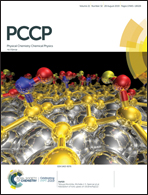Competition between dispersion interactions and conventional hydrogen bonding: insights from a theoretical study on Z-Arg-OH†
Abstract
The dispersion interaction was reported to play a critical role in the stabilization of model dipeptide Z-Arg-OH, even greater than the conventional hydrogen bond (HB), which is opposite to the traditional opinion. Here the conformation of Z-Arg-OH has been systematically searched by the effective fragment based step-by-step strategy. All the newly-found low-energy conformers determined at the advanced DSD-PBEP86-D3(BJ)/aug-cc-pVTZ level are clearly in the stretched form with strong conventional HBs, rather than the reported folded structures with emphasis on the dispersion interactions. The simulated IR spectra of the stretched conformers fit better than those of the folded ones compared with the previous experimental observations. Near-edge X-ray absorption fine-structure (NEXAFS) spectra and X-ray photoelectron spectra (XPS) at C, N and O K-edges have also been simulated to unambiguously identify different isomers. This work thus provides valuable insight into the competitions between the conventional HB and the dispersion interactions and demonstrates that the conventional hydrogen bonding is still more important for such small peptides.



 Please wait while we load your content...
Please wait while we load your content...